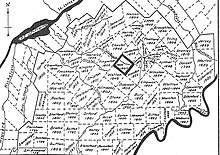Stanstead (Province of Canada electoral district)
 From Wikipedia - Reading time: 5 min
From Wikipedia - Reading time: 5 min
| Defunct pre-Confederation electoral district | |
|---|---|
| Legislature | Legislative Assembly of the Province of Canada |
| District created | 1841 |
| District abolished | 1867 |
| First contested | 1841 |
| Last contested | 1863 |
Stanstead was an electoral district of the Legislative Assembly of the Parliament of the Province of Canada, in Canada East. It was south-east of Montreal, in the Eastern Townships. Created in 1841, it was based on the previous electoral district of the same name for the Legislative Assembly of Lower Canada.
Stanstead was represented by one member in the Legislative Assembly. It was abolished in 1867, upon the creation of Canada and the province of Quebec.
Boundaries
[edit]
Stanstead electoral district was located In the Eastern Townships, south of Montreal (including areas now in Memphrémagog Regional County Municipality and Coaticook Regional County Municipality). The district extended south to the border with the United States.
The Union Act, 1840 merged the two provinces of Upper Canada and Lower Canada into the Province of Canada, with a single Parliament. The separate parliaments of Lower Canada and Upper Canada were abolished.[1] The Union Act provided that the pre-existing electoral boundaries of Lower Canada and Upper Canada would continue to be used in the new Parliament, unless altered by the Union Act itself.[2]
The Lower Canada electoral district of Stanstead was not altered by the Union Act and therefore continued with the same boundaries in the new Parliament. Those boundaries had been set by a statute of Lower Canada in 1829:
Members of the Legislative Assembly (1841–1867)
[edit]Stanstead was a single-member constituency.[2]
The following were the members of the Legislative Assembly for Stanstead. The party affiliations are based on the biographies of individual members given by the National Assembly of Quebec, as well as votes in the Legislative Assembly. "Party" was a fluid concept, especially during the early years of the Province of Canada.[4][5][6]
| Parliament | Members | Years in Office | Party | |||
|---|---|---|---|---|---|---|
| 1st Parliament 1841–1844 |
Marcus Child | 1841–1844 | Unionist; initially government supporter; later "British" Member | |||
| 2nd Parliament 1844–1847 |
John McConnell | 1844–1851 | "British" Tory | |||
| 3rd Parliament 1848–1851 |
Conservative Independent | |||||
| 4th Parliament 1851–1854 |
Hazard Bailey Terrill[a] | 1851–1852 | "English" Moderate | |||
| Timothy Lee Terrill[b] | 1852–1854 | Liberal | ||||
| 5th Parliament 1854–1857 | Timothy Lee Terrill[c] | 1854–1861 | Conservative | |||
| 6th Parliament 1858–1861 |
||||||
| 7th Parliament 1861–1863 |
Albert Knight | 1861–1867 | Conservative | |||
| 8th Parliament | Confederation; Conservative | |||||
Notes
[edit]- ^ Died in office, October 28, 1852: Côté, Political Appointments and Elections, p. 62, note (147).
- ^ Elected in by-election, November 23, 1852: Côté, Political Appointments and Elections, p. 62, note (148).
- ^ Appointed Provincial Secretary, an office of profit under the Crown and vacated seat, May 24, 1856; re-elected in ministerial by-election, June 10, 1856: Côté, Political Appointments and Elections, p. 63, note (196).
Abolition
[edit]The district was abolished on July 1, 1867, when the British North America Act, 1867 came into force, creating Canada and splitting the Province of Canada into Quebec and Ontario.[7] It was succeeded by electoral districts of the same name in the House of Commons of Canada[8] and the Legislative Assembly of Quebec.[9]
See also
[edit]References
[edit]- ^ Union Act, 1840, 3 & 4 Vict., c. 35, s. 2.
- ^ a b Union Act, 1840, s. 18.
- ^ An Act to make a new and more convenient subdivision of the Province into Counties, for the purpose of effecting a more equal Representation thereof in the Assembly than heretofore, SLC 1829, c. 73, s. 1, para. 15.
- ^ J.O. Côté, Political Appointments and Elections in the Province of Canada, 1841 to 1860 (Quebec: St. Michel and Darveau, 1860), pp. 43–58.
- ^ Québec Dictionary of Parliamentary Biography, from 1764 to the present.
- ^ Paul G. Cornell, Alignment of Political Groups in Canada, 1841–67 (Toronto: University of Toronto Press, 1962; reprinted in paperback 2015), pp. 93–111.
- ^ British North America Act, 1867 (now the Constitution Act, 1867), s. 6.
- ^ Constitution Act, 1867, s. 40, para. 2.
- ^ Constitution Act, 1867, s. 80.
![]() This article incorporates text from this source, which is in the public domain: Statutes of Lower Canada, 13th Provincial Parliament, 2nd Session (1829), c. 74
This article incorporates text from this source, which is in the public domain: Statutes of Lower Canada, 13th Provincial Parliament, 2nd Session (1829), c. 74
 KSF
KSF